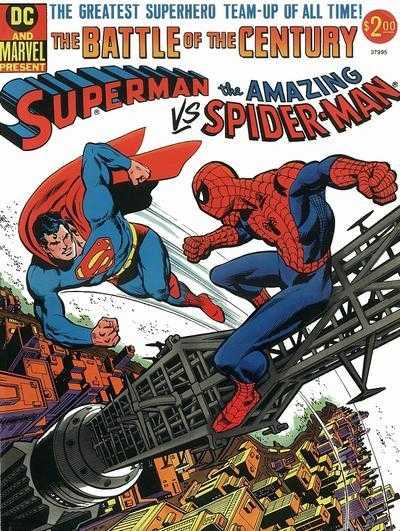RETRO REVIEW: Superman vs. The Amazing Spider-Man
DC Comics/Marvel Comics; $2
With the recent releases of the DC vs. Marvel omnibus editions, it seems like a great time to revisit the first one.
It’s not uncommon for franchises to crossover. In fact, it’s a fairly standard practice in the arena of video games, and it’s not at all unusual in the world of comic books either. Whether we’re talking Aliens vs. Predator (the comic book version spawned the video games and then the movies), Star Trek/X-Men, or even Tarzan on the Planet of the Apes, the financial and creative rewards of such crossovers can be very compelling.
It’s very hard to replicate the impact, however, of the 1976 collaboration of DC Comics and Marvel Comics on their first high profile crossover, Superman vs. The Amazing Spider-Man. In those days, such a thing was just about completely unheard of. It’s impact was bigger than it’s Treasury-size format.
DC Publisher Carmine Infantino developed the cover concept, which was then executed by artist Ross Andru. It helped that in addition to being a talented draftsman, Andru was no stranger to either DC or Marvel. Inker Dick Giordano provided the finishes.
Along with writer Gerry Conway, Andru and Giordano also delivered the story’s interior art, which as the title suggests, initially pitted Superman against Spider-Man (hey, it’s a superhero team-up story, we all know how they start).
With Lex Luthor and Doctor Octopus as the villains, the story and art captured so much of what made comics cool in that era. Personal relationships, egos, trials and tribulations, all combined with bombastic threats from intelligent villains playing out on a grand stage.
Andru and Giordano’s clear storytelling moves the story along briskly. There were also chapter-break asides with the respective origins of the heroes and villains, and the whole package stands up remarkably well.
It’s still a lot of fun, though any kind of higher grade copy is going to cost you a lot more than than the original, almost astronomical $2 cover price.
As a side note, there were a few exceptions, but most of the Treasury-size projects from either company were character-centric, series-centric, or thematic reprint collections. The publishers made the right choice in releasing this one in this format.
– J.C. Vaughn
Popular Topics
Overstreet Access Quick Links
RETRO REVIEW: Superman vs. The Amazing Spider-Man
DC Comics/Marvel Comics; $2
With the recent releases of the DC vs. Marvel omnibus editions, it seems like a great time to revisit the first one.
It’s not uncommon for franchises to crossover. In fact, it’s a fairly standard practice in the arena of video games, and it’s not at all unusual in the world of comic books either. Whether we’re talking Aliens vs. Predator (the comic book version spawned the video games and then the movies), Star Trek/X-Men, or even Tarzan on the Planet of the Apes, the financial and creative rewards of such crossovers can be very compelling.
It’s very hard to replicate the impact, however, of the 1976 collaboration of DC Comics and Marvel Comics on their first high profile crossover, Superman vs. The Amazing Spider-Man. In those days, such a thing was just about completely unheard of. It’s impact was bigger than it’s Treasury-size format.
DC Publisher Carmine Infantino developed the cover concept, which was then executed by artist Ross Andru. It helped that in addition to being a talented draftsman, Andru was no stranger to either DC or Marvel. Inker Dick Giordano provided the finishes.
Along with writer Gerry Conway, Andru and Giordano also delivered the story’s interior art, which as the title suggests, initially pitted Superman against Spider-Man (hey, it’s a superhero team-up story, we all know how they start).
With Lex Luthor and Doctor Octopus as the villains, the story and art captured so much of what made comics cool in that era. Personal relationships, egos, trials and tribulations, all combined with bombastic threats from intelligent villains playing out on a grand stage.
Andru and Giordano’s clear storytelling moves the story along briskly. There were also chapter-break asides with the respective origins of the heroes and villains, and the whole package stands up remarkably well.
It’s still a lot of fun, though any kind of higher grade copy is going to cost you a lot more than than the original, almost astronomical $2 cover price.
As a side note, there were a few exceptions, but most of the Treasury-size projects from either company were character-centric, series-centric, or thematic reprint collections. The publishers made the right choice in releasing this one in this format.
– J.C. Vaughn








